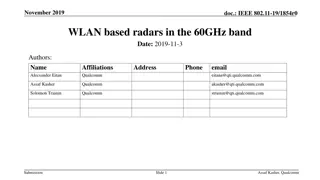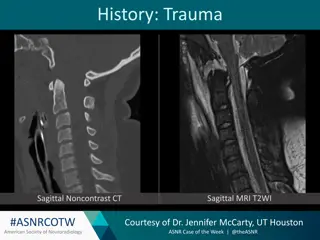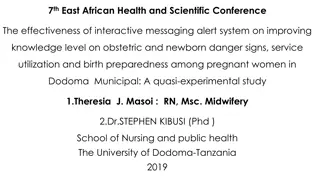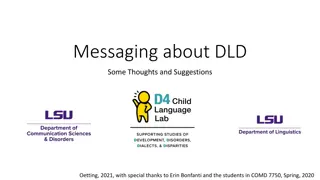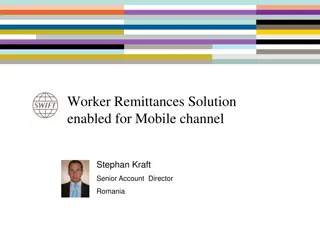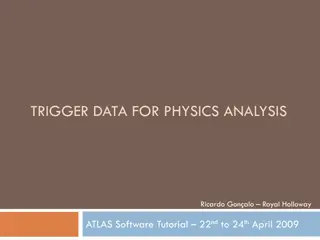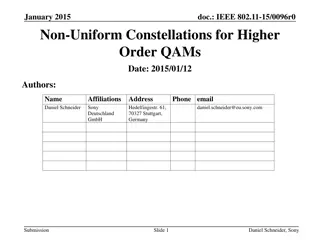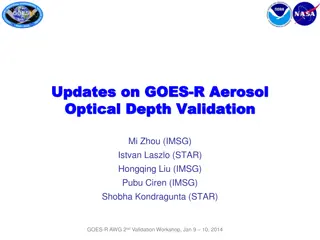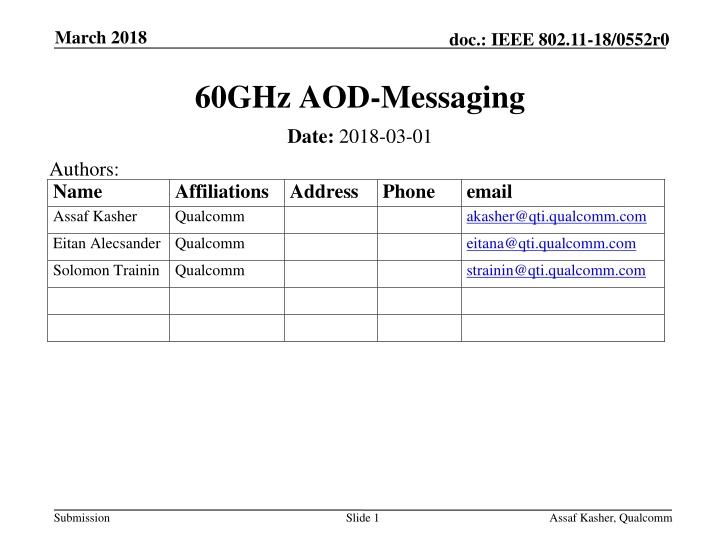
IEEE 802.11-18/0552r0 March 2018: AOD Messaging Protocol in 60GHz
Explore the protocol and message modifications required to implement Angle of Departure (AOD) in the 60GHz direction measurement protocol as discussed in the March 2018 IEEE document authored by Assaf Kasher, Eitan Alecsander, and Solomon Trainin from Qualcomm. The presentation addresses the transfer of critical feedback, proposed solutions, and dealing with AOD challenges between Initiators and Responders in the context of FTM exchanges.
Download Presentation

Please find below an Image/Link to download the presentation.
The content on the website is provided AS IS for your information and personal use only. It may not be sold, licensed, or shared on other websites without obtaining consent from the author. If you encounter any issues during the download, it is possible that the publisher has removed the file from their server.
You are allowed to download the files provided on this website for personal or commercial use, subject to the condition that they are used lawfully. All files are the property of their respective owners.
The content on the website is provided AS IS for your information and personal use only. It may not be sold, licensed, or shared on other websites without obtaining consent from the author.
E N D
Presentation Transcript
March 2018 doc.: IEEE 802.11-18/0552r0 60GHz AOD-Messaging Date: 2018-03-01 Authors: Name Assaf Kasher Affiliations Address Qualcomm Phone email akasher@qti.qualcomm.com Eitan Alecsander Qualcomm eitana@qti.qualcomm.com Solomon Trainin Qualcomm strainin@qti.qualcomm.com Submission Slide 1 Assaf Kasher, Qualcomm
March 2018 doc.: IEEE 802.11-18/0552r0 Abstract This presentation describes the protocol and message changes needed to enable use of Angle of Departure (AOD) in 60GHz Direction measurement protocol Submission Slide 2 Assaf Kasher, Qualcomm
Responding STA Initiating STA March 2018 doc.: IEEE 802.11-18/0552r0 Problem Statement Initial FTM Request(Parameters) ACK FTM_1(0,0,Parameters) While it is well defined within the protocol how AOA is sent from the responder to the initiator. It is not clear how to return either the Best Sector/Channel Measurement feedback or the final AOD results. What needs to be sent: Both initiator and responder need to be able to send Best Sector and Channel Measurement results Responder need to be able to send AOD results Basic Assumption: Only the ISTA needs final direction information. ACK FTM Request(Trigger) ACK t1 (m=1) FTM_2(0,0,TRN field) t2 (m=1) t3 (m=1) ACK+TRN Field t4 (m=1) t1 (m=2) FTM_3(t1_2,t4_2,AOA) t2 (m=2) t3 (m=2) ACK t4 (m=2) t1 (m=3) FTM_4(t1_3,t4_3) t2 (m=3) t3 (m=3) ACK t4 (m=3) FTM_5(t1_4,t4_4,AOA) ACK Submission Slide 3 Assaf Kasher, Qualcomm
March 2018 doc.: IEEE 802.11-18/0552r0 What Information Needs To be transferred? For Initiator to responder AOD: Responder Shall send the BS feedback and/or Channel Measurement Feedback Initiator determines AOD based on this information Proposed Solution: Add BS_feedback field to Direction Measurement Results field and enable adding Channel Measurement Feedback to FTM frame enables orientation For Responder to Initiator AOD: Initiator shall send the BS feedback and/or Channel Measurement Feedback Responder shall estimate AOD based on this information and send AOD to the initiator Problem: During FTM exchanges, the initiator sends only ACKs Important enables direction and location (with ranging) Assaf Kasher, Qualcomm Submission Slide 4
Slide 5 March 2018 doc.: IEEE 802.11-18/0552r0 How can we deal with the I2R AOD? The responder collects the BS Feedback results during the burst. After the burst, the initiator sends an FTM Measurement Frame to the responder, with a list of BS feedback results, the responder responds with an ACK Multiple Channel Measurement Feedback Channel Measurement Feedback is an element used in DMG. The responder (possibly after taking time for calculation) responds with an FTM Measurement Frame to the initiator, including a list of AOD results Submission Assaf Kasher, Qualcomm
Slide 6 March 2018 doc.: IEEE 802.11-18/0552r0 Elements to be added Multiple BS feedback Element 1O 1O 1O 1O B0 B7 B8 B18 B19 B29 Element ID Extension Element Id Element Length Number of BS Feedback Results BS Feedback 1 BS Feedback 2 BS Feedback N Reserved Multiple AOD Element 1O 1O 1O 1O B0 B7 B8 B17 B18 B27 Element ID Extension Element Id Element Length Number of AOD AOD1 BS Feedback 2 BS Feedback N Reserved Submission Assaf Kasher, Qualcomm
doc.: IEEE 802.11-18/0552r0 Responding STA Initiating STA Initial FTM Request(Parameters) Protocol Modification ACK Two exchanges added after the end of the burst Each of them is a separate channel access In the first exchange: Multiple BS feedback are sent from the initiator to the responder in an FTM frame In the second exchange Multiple AOD results are sent from the responder to the initiator in an FTM frame. FTM_1(0,0,Parameters) ACK FTM Request(Trigger) ACK t1 (m=1) FTM_2(0,0,TRN field) t2 (m=1) t3 (m=1) ACK+TRN Field t4 (m=1) t1 (m=2) FTM_3(t1_2,t4_2, AOD) t2 (m=2) t3 (m=2) ACK t4 (m=2) FTM_5(t1_2,t4_3) ACK FTM(Multiple BS Feedbacki) ACK FTM(Multiple AOD Feedback) ACK Submission Slide 7 Assaf Kasher, Qualcomm
March 2018 doc.: IEEE 802.11-18/0552r0 References Submission Slide 8 Assaf Kasher, Qualcomm






